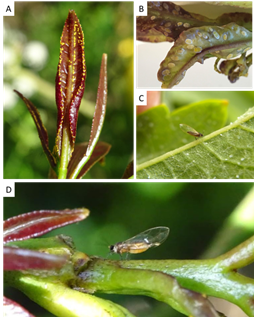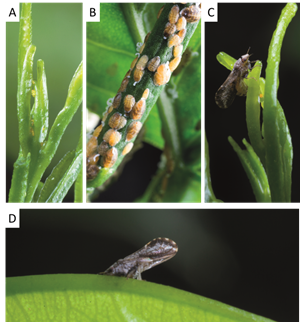Questions and answers
It is a disease caused by a bacterium in citrus fruit, whose most characteristic symptom is a diffuse and asymmetrical mottling of the leaves, easy to confuse with symptoms of nutritional deficiencies. Although it has not come to Europe yet but, if it were to reach this region, the consequences of its arrival could be devastating for the citrus sector.
It originates from Southeast Asia, where the first references date back to the end of the 19th century. It spread throughout the tropical and subtropical regions of Asia, spreading to all citrus-growing areas except Japan. Subsequently, it was detected in Brazil and in 1998 in Florida, reaching Mexico in 2009. On the African continent, the disease is widespread in South Africa.
The main symptoms of HLB are listed below:
Leaves:
- Diffuse, asymmetrical yellowish mottling appears, irregularly distributed on both sides of the midrib of the leaf.
- Thickening and thinning of the veins occurs.
- The first infected leaves usually appear in the upper part of the tree crown.
Fruit:
- The fruit of HLB-affected trees is deformed, reduced in size, and thicker-skinned.
- Internally, the seeds are aborted and darker in colour.
- They produce less juice which is more acidic and bitter than that of healthy fruit.
The only officially accepted and safe method is the PCR technique. There are visual methods based on symptomatology, however, it is not 100% certain.
It can be transmitted by grafting or by a vector.
The vectors transmitting HLB are the African psylla Trioza erytreae and the Asian psylla, Diaphorina citri.
Symptoms of Trioza erytreae: Adult females deposit orange eggs on tender shoots, where a few days after nymph emergence, typical galls form on the underside of the leaf. Feeding of the nymphs promotes the formation of balloon-like galls on the upper side of the leaf, and concave hollows on the underside, where the nymph is found until it completes its development. In addition, these nymphs are found by waxy filaments that favour the development of fungi.
Symptoms of Diaphorina citri: Their feeding causes the leaves to curl and in case of massive infestation, new shoots can be severely injured or even die.
In addition, they excrete large quantities of white honeydew, which sometimes turns black due to fungal colonisation.
.
HLB has not yet reached Europe, but Trioza erytreae, one of its vectors, which was first identified in the Canary Islands in 2002, reached the Iberian Peninsula in 2014; specifically, it has been identified in Galicia and northern Portugal. Trioza erytreae has now spread across Portugal as far as Lisbon.
The economic consequences of HLB are devastating, mainly due to the decrease in production and quality of production due to either the infection of the trees or their destruction to eliminate the source of the bacteria, as well as the increased cost of chemical treatments to control the vectors.
In Asia, more than 100 million infected trees have been removed. In Sao Paulo (Brazil), more than 56 million trees have been removed in the last 15 years. In Florida (USA), where infected trees are not removed, the greatest impact has been recorded: 10 years after the first detection of HLB, 90 % of the citrus growing area had 100 % of the trees infected, and a drop in production of more than 60 %. The resulting economic impact has been estimated at USD 3.9 billion. If HLB were to reach the Mediterranean basin, the impact would be even worse, as small plantations predominate, where the spread of the disease would be even more difficult to control.
HLB is a disease affecting all citrus varieties (commercial and non-commercial), as well as other plants of related genera, some of them used as ornamentals or as rootstocks.
There is currently no cure for HLB, but numerous studies are being carried out in this area. In addition, there are several projects using natural enemies for biological control of the vectors, which are expected to achieve encouraging results for the citrus sector.
The first step in identifying the transmitting vectors is to know in detail their physical characteristics.
- In the case of Trioza erytreae, this insect is characterised by being winged, brown in the case of adults and light green when they hatch, the most distinctive feature being the angle of approximately 35º they form with the surface when they land on a leaf to feed. Adults are between 2 and 4 mm in length. Eggs are orange, cylindrical, with a sharp point. They are located on the margins of young leaves.

- In the case of Diaphorina citri, while feeding, they position themselves at a 45° angle on the leaf. It is distinguished from the other species by the pattern of spots on its forewings: they have a dark band along the outer edge and a white area in the centre with irregular spots. Eggs are always laid on tender shoots and young leaves, are oval, less than 0.5 mm long and dull yellow in colour, turning orange as they mature. They take 2-4 days to hatch, when the nymphs (immature insects) appear. These are flattened, small, yellow-orange, unspotted, with a pair of red eyes and black antennae. Initially they move slowly to select a feeding site, and once they begin to do so, they secrete a large quantity of white honeydew. The young adult has a whitish body, which turns brown as it ages. Females are larger (3 x 1 mm) than males (2.5 x 0.8 mm).

Secondly, it is necessary to carefully observe any symptoms of any of the vectors, as well as of the disease itself. In the case of the vectors, the use of colour traps and a magnifying glass is recommended, due to the small size of the vectors.
In this context, and with the aim of facilitating the identification of both the vectors and the disease, a free App is being developed within the scope of this Pre-HLB project.
If there is a suspicion of having identified any of the vectors or the disease, you should report it to the competent plant health authority in your area.
Border detection protocols are in place to prevent the entry of plant material infected by HLB, as well as by any other pest or disease.

Questions to Ask When Making Appointments
Praesent sed aliquam ipsum, ut placerat nunc. Sed nec dolor massa. Donec condimentum sem at urna dapibus, quis congue ipsum finibus. In ut ultrices enim.
Duis semper efficitur dui, sit amet venenatis ipsum vestibulum sit amet. In sodales purus sed mattis tempus. Ut auctor scelerisque pharetra.
Aenean tempor, arcu vitae maximus ornare, erat dolor volutpat augue, quis aliquam nibh ligula non mi. Maecenas tincidunt neque quis purus rutrum pulvinar.
Duis semper efficitur dui, sit amet venenatis ipsum vestibulum sit amet. In sodales purus sed mattis tempus. Ut auctor scelerisque pharetra.
Integer imperdiet nibh nisi. Integer vehicula vestibulum leo, eget lacinia sem iaculis non. Aliquam orci augue, pellentesque nec ex nec, tincidunt tristique tellus.
Aliquam erat volutpat. In in augue elit. Nunc sagittis metus tristique, consectetur ex rhoncus, vehicula diam. Etiam facilisis lacus accumsan, vulputate risus quis, imperdiet odio.
